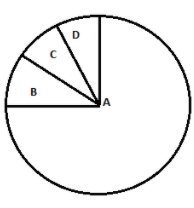
Given below is the representation of the extent of global diversity of invertebrates. What groups the four positions (A-D) represent respectively?

A) A-Insects; B-Crustaceans; C- Other animal Groups; D- Molluscs
B) A-Crustaceans; B-Insects; C- Molluscs; D- Other animal groups
C) A-Molluscs; B-Other animal groups; C - Crustaceans; D- Insects
D) A-Insects ; B- Molluscs ; C- Crustaceans; D-Other animal groups

Answer
567.9k+ views
Hint: Invertebrates are animals without a backbone or bony skeleton. They range from spiders and scorpions to centipedes and millipedes, crustaceans, insects, crabs, worms, leeches, earthworms, mussels and clams, snails, squid and octopi, sea anemones and corals, among others.
Complete answer:
Among animals, insects are the most diverse group. There are more than 900 thousand different kinds of living insects known. There are 1.5 million species of beetles which makes insects the largest diverse group.There are some 100 thousand molluscs species present after insects which make them the second largest group. Most of them are marine. Crustaceans come after molluscs. They are part of the phylum Arthropoda. Crustaceans include animals as crabs, lobsters, crayfish, shrimps, prawns, krill, woodlice, and barnacles. Other animal groups combinally indicate the last position in the chart.
Additional information:
97 percent of all animals are invertebrates. These animals neither possess nor develop a vertebral column or backbone. They are cold blooded animals. The term invertebrate comes from a Latin word, in- meaning “not” and vertebrate meaning “backbone”. Hence invertebrates are a group of animals that do not have backbone.
Thus correct answer is option D. i.e., A-Insects; B- Molluscs; C- Crustaceans; D-Other animal groups.
Note:There are two basic groups of higher animals. They are vertebrates and invertebrates. Both invertebrates and vertebrates lack a cell wall, they are heterotrophic, and most of them exhibit symmetry. They are also multicellular.
Complete answer:
Among animals, insects are the most diverse group. There are more than 900 thousand different kinds of living insects known. There are 1.5 million species of beetles which makes insects the largest diverse group.There are some 100 thousand molluscs species present after insects which make them the second largest group. Most of them are marine. Crustaceans come after molluscs. They are part of the phylum Arthropoda. Crustaceans include animals as crabs, lobsters, crayfish, shrimps, prawns, krill, woodlice, and barnacles. Other animal groups combinally indicate the last position in the chart.
Additional information:
97 percent of all animals are invertebrates. These animals neither possess nor develop a vertebral column or backbone. They are cold blooded animals. The term invertebrate comes from a Latin word, in- meaning “not” and vertebrate meaning “backbone”. Hence invertebrates are a group of animals that do not have backbone.
Thus correct answer is option D. i.e., A-Insects; B- Molluscs; C- Crustaceans; D-Other animal groups.
Note:There are two basic groups of higher animals. They are vertebrates and invertebrates. Both invertebrates and vertebrates lack a cell wall, they are heterotrophic, and most of them exhibit symmetry. They are also multicellular.
Recently Updated Pages
Master Class 11 Economics: Engaging Questions & Answers for Success

Master Class 11 English: Engaging Questions & Answers for Success

Master Class 11 Social Science: Engaging Questions & Answers for Success

Master Class 11 Biology: Engaging Questions & Answers for Success

Class 11 Question and Answer - Your Ultimate Solutions Guide

Master Class 11 Business Studies: Engaging Questions & Answers for Success

Trending doubts
What is meant by exothermic and endothermic reactions class 11 chemistry CBSE

10 examples of friction in our daily life

One Metric ton is equal to kg A 10000 B 1000 C 100 class 11 physics CBSE

Difference Between Prokaryotic Cells and Eukaryotic Cells

What are Quantum numbers Explain the quantum number class 11 chemistry CBSE

1 Quintal is equal to a 110 kg b 10 kg c 100kg d 1000 class 11 physics CBSE




